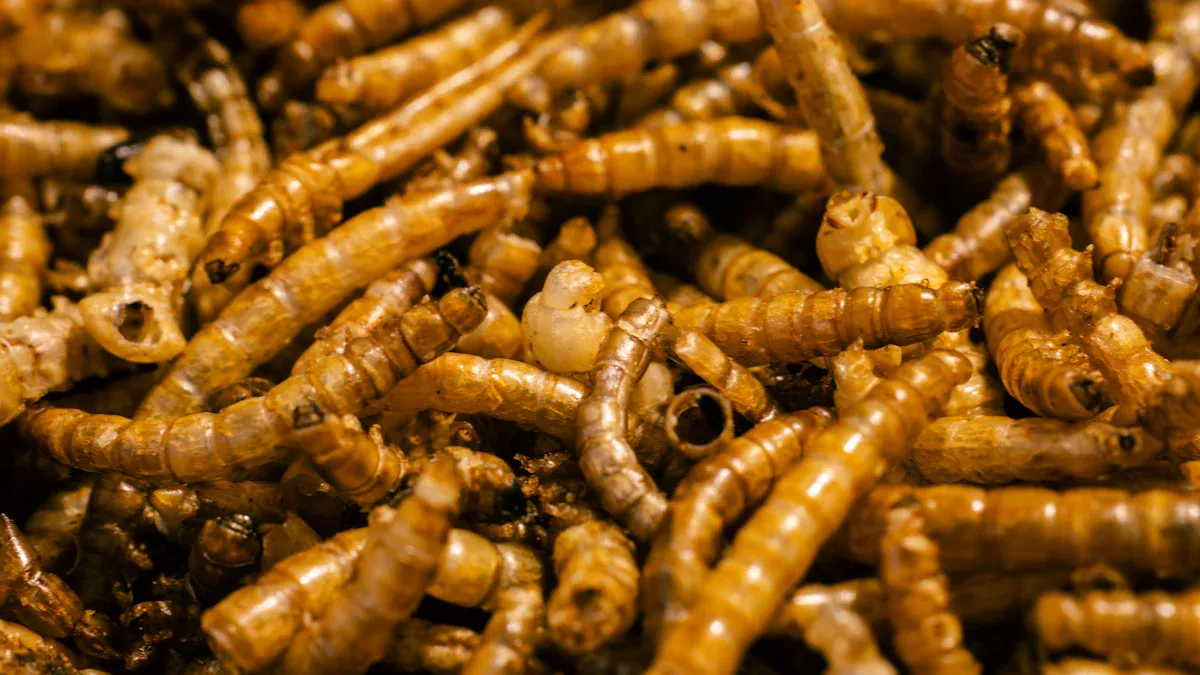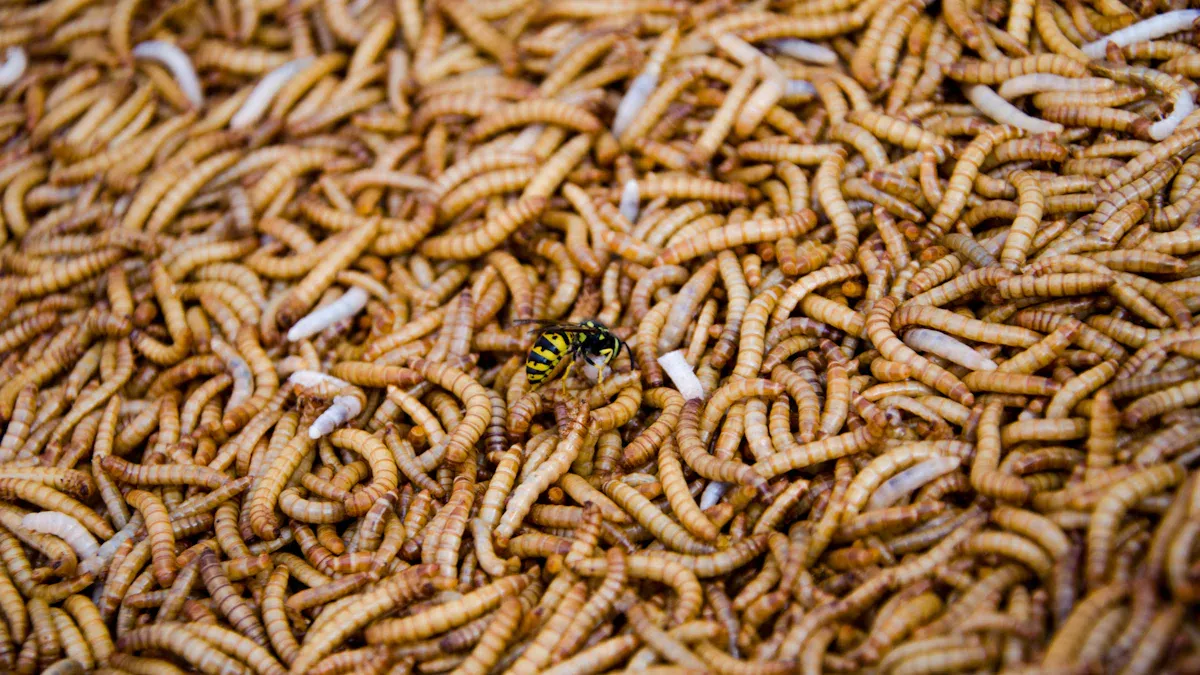
Aquaculture faces growing challenges, from overfishing to environmental concerns. Yellow mealworm (Tenebrio molitor) meal offers a game-changing solution. It replaces fishmeal and soybean meal in aquafeed, ensuring consistent production. Mealworms for Aquaculture provide high protein, healthy fats, and essential nutrients, boosting fish growth naturally. Their farming also reduces waste and resource use, making them a sustainable choice.
Overfishing threatens traditional feed sources. Innovative solutions like mealworms can secure aquaculture’s future while reducing its ecological footprint.
Key Takeaways
- Mealworms are a greener option than regular fish feed. They use less water and land and cut down on harmful gases.
- Mealworms are high in protein, helping fish grow strong and stay healthy. This makes them useful for fish farming.
- Growing mealworms can make jobs and lower costs. It helps local communities and supports eco-friendly methods.
Challenges in Traditional Fish Feed Practices
Overuse of Fishmeal and Fish Oil
Fishmeal and fish oil have been the backbone of aquaculture feed for decades. However, their overuse has led to significant problems. Many fisheries are overexploited, putting wild fish stocks at risk. This practice not only disrupts marine ecosystems but also raises ethical concerns about the sustainability of these resources.
The environmental impact is equally alarming. Producing fishmeal and fish oil contributes to global warming, acidification, and eutrophication. It also consumes large amounts of energy and water. These issues highlight the urgent need to rethink how aquaculture feed is sourced.
Environmental and Economic Drawbacks
The reliance on fishmeal and fish oil isn’t just an environmental issue—it’s an economic one too. As wild fish stocks dwindle, the production of fishmeal has stagnated. Meanwhile, the demand for aquaculture feed continues to grow. This imbalance has caused fishmeal prices to skyrocket, making it less viable for fish farmers.
| Assertion | Description |
|---|---|
| 1 | Demand for food fish will grow (FAO, 2000). |
| 2 | Increased supplies of food fish can only come from aquaculture due to overexploitation of wild fish stocks (FAO, 2000). |
| 3 | The proportion of aquaculture relying on feeds with fishmeal and fish oil will grow rapidly. |
| 4 | Growing aquaculture production will require an increasing share of fishmeal for aquafeeds. |
| 5 | Fishmeal production has been static and is likely to remain so. |
| 6 | Therefore, the price of fishmeal will increase drastically, forcing aquaculture to reduce reliance on fishmeal. |
The Urgent Need for Sustainable Alternatives
The aquaculture industry must find sustainable alternatives to traditional feed ingredients. Yellow mealworm (Tenebrio molitor) meal has emerged as a promising solution. It provides a high-quality protein source that can replace fishmeal and soybean meal, ensuring consistent aquaculture production.
Innovative companies are already exploring alternatives. For example, Ittinsect uses agri-food by-products to create insect-based feed, while NovoNutrients produces fishmeal substitutes from CO2-consuming bacteria. These solutions not only reduce the environmental footprint of aquaculture but also address the growing demand for sustainable practices.
The shift from traditional feed to alternatives like mealworms for aquaculture is essential for protecting marine ecosystems and ensuring the industry’s future.
Mealworms for Aquaculture: A Sustainable Solution

Nutritional Benefits for Fish Growth
Yellow mealworm (Tenebrio molitor) meal has proven to be a game-changer in aquafeed. It serves as a high-quality protein source, replacing fishmeal and soybean meal while ensuring consistent aquaculture production. Mealworms offer a rich nutritional profile that supports fish growth and health.
| Nutritional Component | Description |
|---|---|
| Protein | Mealworms provide around 50-60% protein by dry weight, essential for fish growth and health. |
| Essential Amino Acids (EAA) | Mealworms contain adequate EAA to meet the dietary requirements of tilapia. |
| Healthy Fats | Includes omega-3 and omega-6 fatty acids, critical for fish physiology and quality of flesh. |
| Dietary Fiber | Contributes to digestive health in fish. |
| Vitamins | Rich in B vitamins, supporting various metabolic functions. |
| Minerals | Contains calcium, phosphorus, and iron, important for overall fish health. |
This nutrient-dense profile makes mealworms an excellent choice for aquaculture, promoting better growth performance and healthier fish.
Environmental Advantages of Mealworm Farming
Mealworm farming offers significant environmental benefits compared to traditional fish feed production. It requires far less land and water while emitting fewer greenhouse gases. For instance, mealworm production uses approximately 10 times less land and 20 times less water than beef production.
| Parameter | Mealworms | Traditional Livestock |
|---|---|---|
| Land Required (for 1 kg) | Much less | More |
| Greenhouse Gas Emissions | Significantly lower | Higher |
| Feed Conversion Efficiency | Similar to poultry | Lower |
| Nitrogen Use Efficiency | Higher | Lower |
Additionally, mealworm-based meals can reduce the demand for fishmeal in aquaculture, further alleviating pressure on marine ecosystems. Their production also enhances sustainability when high-quality feed sources are used.
Cost-Effectiveness and Scalability
Scaling up mealworm farming for aquaculture presents both challenges and opportunities. The projected investment in this sector is expected to reach $11 billion by 2035, reflecting its growing potential. Production costs vary depending on facility efficiency, ranging from $2.7K to $19K per ton of dried insects annually.
Despite these costs, mealworms offer long-term economic benefits. They create job opportunities in farming, food processing, and distribution. Their lower resource requirements, such as reduced land and water use, make them a cost-effective alternative to traditional livestock. As technology advances, mealworm farming is becoming more scalable, paving the way for broader adoption in aquaculture.
Mealworms for Aquaculture not only support sustainable fish farming but also promise economic and environmental advantages, making them a viable solution for the future.
Real-World Applications of Mealworms in Aquaculture
Companies Leading the Way
Several companies are spearheading the development of mealworm-based fish feed, showcasing its potential in aquaculture. Ÿnsect, a global leader in insect protein production, has made significant strides by acquiring Protifarm, a Dutch mealworm farming company. This move has strengthened their capacity to supply mealworms for aquafeed and pet food. Other notable players include Protix, TEBRIO, and Bühler Group, all of which are driving innovation in this space.
Here’s a quick look at some of the key companies making an impact:
- Ynsect
- Protix
- TEBRIO
- MealFood Europe
- Beta Hatch
- HiProMine S.A
These companies are not only advancing mealworm farming but also addressing sustainability challenges in aquaculture.
Case Studies of Success
Mealworms have already proven their value in aquaculture through real-world applications. For instance, a study on red hybrid tilapia demonstrated that mealworm-based feed could replace traditional fishmeal without harming the fish’s body composition or organ health. This success highlights mealworms as a viable protein source for consistent aquaculture production.
In the U.S., mealworm aquaculture is gaining traction as a sustainable solution to food security and environmental concerns. Their low resource requirements, such as minimal land and water use, make them an eco-friendly alternative. These case studies underline the growing acceptance of mealworms in the industry.
Innovations in Mealworm-Based Fish Feed
Innovative technologies are transforming how mealworms are incorporated into fish feed. For example, advanced breeding techniques and automated systems have streamlined production, making mealworm farming more efficient. Bioconversion methods, which use organic waste to feed mealworms, further enhance sustainability.
| Innovation Type | Description |
|---|---|
| Advanced Breeding Techniques | Streamlined processes for breeding mealworms to enhance production efficiency. |
| Automated Systems | Implementation of technology to automate harvesting and processing, reducing labor costs. |
| Bioconversion Methods | Techniques that convert organic waste into mealworm feed, promoting sustainability. |
These advancements ensure that mealworms for aquaculture remain a cost-effective and scalable solution, paving the way for broader adoption in fish farming.
Addressing Challenges in Mealworm Adoption
Overcoming Scalability and Cost Barriers
Scaling up mealworm farming for aquaculture presents unique challenges. While Yellow mealworm (Tenebrio molitor) meal has proven to be a suitable protein source to replace fishmeal and soybean meal, consistent production at scale remains a hurdle. High production costs, driven by reliance on food-grade or imported substrates, limit its feasibility. Feed alone accounts for nearly a quarter of mealworm farming expenses, making cost reduction a priority.
Competition from traditional protein sources like fishmeal further complicates scalability. Mealworm farming also requires significant investment in infrastructure and technology to streamline breeding, harvesting, and processing. However, advancements in automation and bioconversion methods offer hope. These innovations can lower costs and improve efficiency, paving the way for broader adoption in aquaculture.
Regulatory and Consumer Acceptance
Regulatory frameworks vary widely across regions, creating obstacles for mealworm-based fish feed. Stringent food safety guidelines and compliance requirements slow market entry. Some countries remain hesitant to embrace insect-based feeds, while others are more receptive. Additionally, the unsustainable practice of breeding mealworms on food-grade substrates raises concerns about long-term regulatory approval.
Consumer perception poses another challenge. Many people view insects as unfamiliar or even unappealing. Concerns about taste, safety, and potential allergens often overshadow the nutritional and environmental benefits of mealworms. Educational initiatives can help shift these perceptions. Highlighting mealworms’ sustainability and processing them into familiar forms can make them more acceptable to consumers.
Research and Development for Broader Use
Ongoing research continues to unlock the potential of mealworms in aquaculture. Studies show that up to 25% of traditional fish feed can be replaced with mealworms without affecting yield. In shrimp farming, complete replacement of fishmeal with mealworms has even improved body weight and lipid content. However, challenges remain. Mealworms lack omega-3 fatty acids, which are crucial for fish nutrition.
Further research aims to optimize dietary proportions and address sustainability concerns. Innovations in breeding practices and substrate use could make mealworm farming more viable. With continued investment, mealworms could significantly reduce reliance on traditional fishmeal, transforming global fish farming practices for the better.
Mealworms, particularly Yellow mealworm (Tenebrio molitor) meal, have emerged as a transformative solution for aquaculture. Their benefits include:
- Sustainability: Farming mealworms requires less water, land, and resources compared to traditional livestock.
- Enhanced Palatability: Fish readily accept mealworms, promoting natural feeding behaviors.
- Health Benefits: High protein content supports better growth and reproduction in fish.
| Benefit | Description |
|---|---|
| Environmental Impact | Mealworm farming emits fewer greenhouse gases and uses less land and water. |
| Economic Benefit | Local production reduces costs and creates jobs in the community. |
| Nutritional Benefits | Mealworms improve fish growth and reduce reliance on fishmeal. |
Continued innovation in breeding, harvesting, and education will unlock mealworms’ full potential. By investing in these areas, the aquaculture industry can adopt mealworms widely, ensuring sustainable fish farming for future generations.
FAQ
What makes Yellow mealworm (Tenebrio molitor) meal a good alternative to fishmeal?
Yellow mealworm meal offers high protein, essential amino acids, and healthy fats. It replaces fishmeal and soybean meal, ensuring consistent aquaculture production while reducing environmental impact.
Are mealworms safe for fish and the environment?
Yes! Mealworms are safe for fish and eco-friendly. Their farming uses fewer resources, emits less greenhouse gas, and reduces reliance on overfished marine stocks.
How can mealworm-based feed benefit fish farmers?
Mealworm-based feed improves fish growth and health. It’s cost-effective, scalable, and sustainable, helping farmers meet growing demand while lowering production costs over time. 🐟


